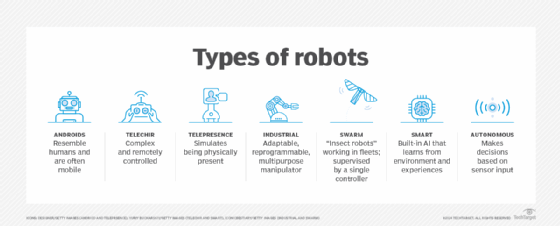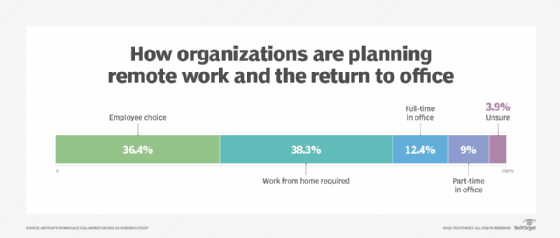telepresence robot
What is a telepresence robot?
A telepresence robot is a robotic device that enables a user to maintain a virtual presence in a remote location. The user can control the robot's movements and other behavior through a computer, tablet or smartphone that is connected to the internet or other network. Through this connection, the robot acts as the user's eyes and ears, enabling that person to see and hear what the robot sees and hears, as though the user is in the same room as the robot, even if they're located on different sides of an ocean. This is called teleoperations.
The telepresence robot includes a video camera and microphone that enable the user to maintain a presence in the remote environment. The robot also provides a screen and speaker so people at the remote location can see and hear the user. In this way, the user can engage in two-way communications with the people at the remote location, similar to a Skype, Teams or Slack call, but with added mobility and remote control.

Some robots contain built-in audiovisual equipment that is integrated into the robot, while others require a smartphone or tablet to be attached to the device. The robots also use various forms of communication, such as 5G, Wi-Fi or Bluetooth. The rise of 5G and advancements in artificial intelligence (AI) technologies are powering more intelligent and versatile telepresence robots.
Many telepresence robots sit on wheels so they can roll from one spot to another in the remote location, assuming that the floor is flat enough and free from obstacles. The user can control the robot's movements, making it possible to drive the robot around the facility. The user can also aim the camera at a specific target or angle. In some cases, the user can raise and lower the camera or zoom in and out, depending on the model. A robot might also include features such as a laser pointer, automatic docking or obstacle detection when moving around.

Where are telepresence robots used?
Telepresence robots can be used in a wide range of environments and support various use cases. For example, organizations might deploy robots as security guards to patrol their office buildings or warehouses, or they might also use them to enable managers to view operations at a remote location, such as an assembly line in a manufacturing plant.
One of the most promising areas for the use of telepresence robots is the medical field. Surgeons could use robots to advise their medical colleagues when they're carrying out procedures on patients in distant locations. In addition, doctors could use telepresence robots when performing hospital rounds or working with patients in extended-care facilities or long-term residences.
Another option is to use telepresence robots to monitor and communicate with patients after they've gone home from the hospital. Robots might also be useful in helping to limit the spread of infectious diseases, protecting the patient, the medical staff or both.
Another promising area for telepresence robots is education. For example, a teacher in a remote location could use a telepresence robot to interact with students directly. In this scenario, the robot could move around the room and engage with students on a one-to-one basis, similar to an on-premises instructor. This approach could be especially useful if a teacher specializes in a topic that is not available in the local school district.
Telepresence robots also make it possible for students with illnesses or disabilities to participate remotely in a class. In the same sense, businesses can use them to enable employees whose disabilities, locations or other circumstances prevent them from being physically present at work -- in which case, they can still have a virtual presence in the office.

Examples of telepresence robots
Numerous companies now offer telepresence robots for different use cases. The following examples provide a general overview of some of the products now on the market:
- Ava Robotics' Ava Robot. Powered by Ava Cloud Service, Ava Robot provides users with intelligent, autonomous navigation capabilities for moving through large offices, event spaces or retail establishments. The robot comes with embedded security features, such as encryption, HTTPS management and password protection, to help protect the organization's IT infrastructure. Ava Robot includes a front camera for the main view and side cameras for peripheral vision.
- Double Robotics' Double 3. The Double 3 robot sits on a wheel base and has an extendable pole that supports variable heights. The device includes an array of sensors for understanding and maneuvering its environment. It also contains two 13-megapixel cameras that can pan, tilt and zoom, along with six microphones and an amplified speaker. In addition, Double Robotics provides an application programming interface that developers can use to build customized apps. The Double 3 robot is designed for a business environment to enhance telecommuting or teleconferencing.
- OhmniLabs Ohmni Pro. The Ohmni Pro robot has a stable three-wheel base and includes an intelligent drive feature with automatic speed adjustment and advanced collision avoidance. The device comes with two high-definition cameras, a 15-watt full-range speaker, a quad-mic array and a responsive neck that provides a 130-degree tilt range. The robot connects to the network via Wi-Fi 5 and has a foldable arm that makes it more portable than many other models.
- Vecna VGo. Using the VGoNet cloud computing network, an internet-connected user can communicate directly with a VGo device in a remote facility, regardless of location. VGo is designed to help healthcare providers deliver lower-cost services and high-quality virtual care. It has also been used by homebound students to attend school virtually and by families who want to stay in contact with their loved ones in long-term care facilities.

Although telepresence robots can cost thousands of dollars, they are often more affordable than what it costs to ensure that someone is physically present at a location, especially when taking into account travel expenses and other overhead. Robots also make it possible to ensure someone's presence when that person can't be physically present at that location.
Though seemingly similar in concept, telepresence and video conferencing have different approaches to virtual meetings. Explore the similarities and differences between telepresence and video conferencing. Also, see how the application of AI in robotics boosts enterprise robot potential.







